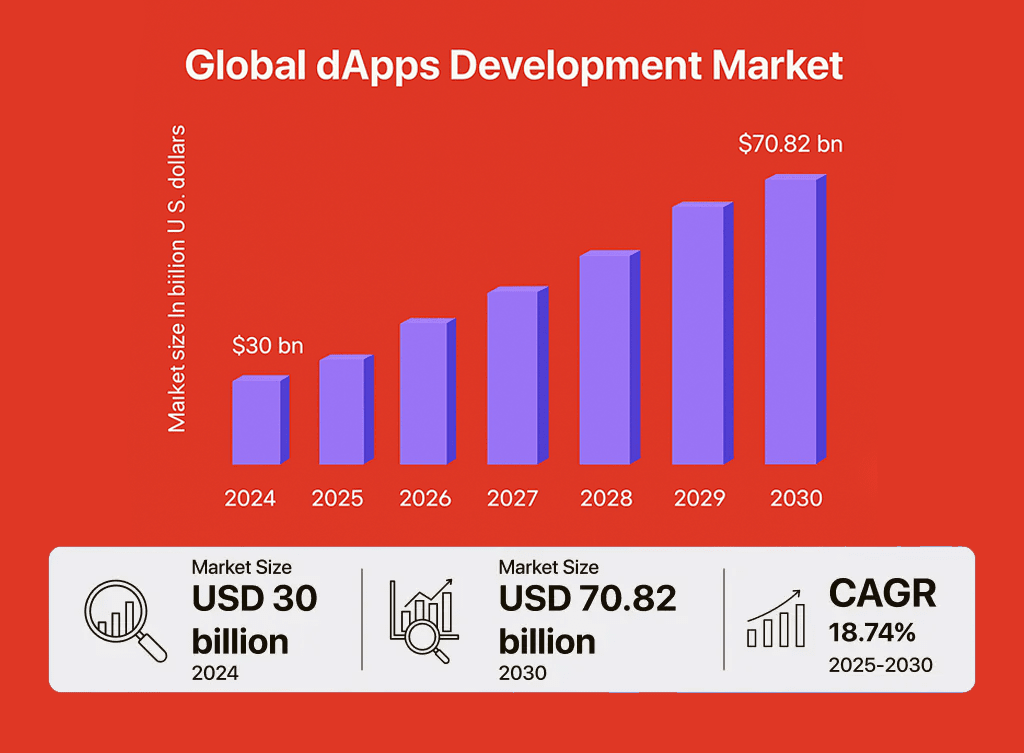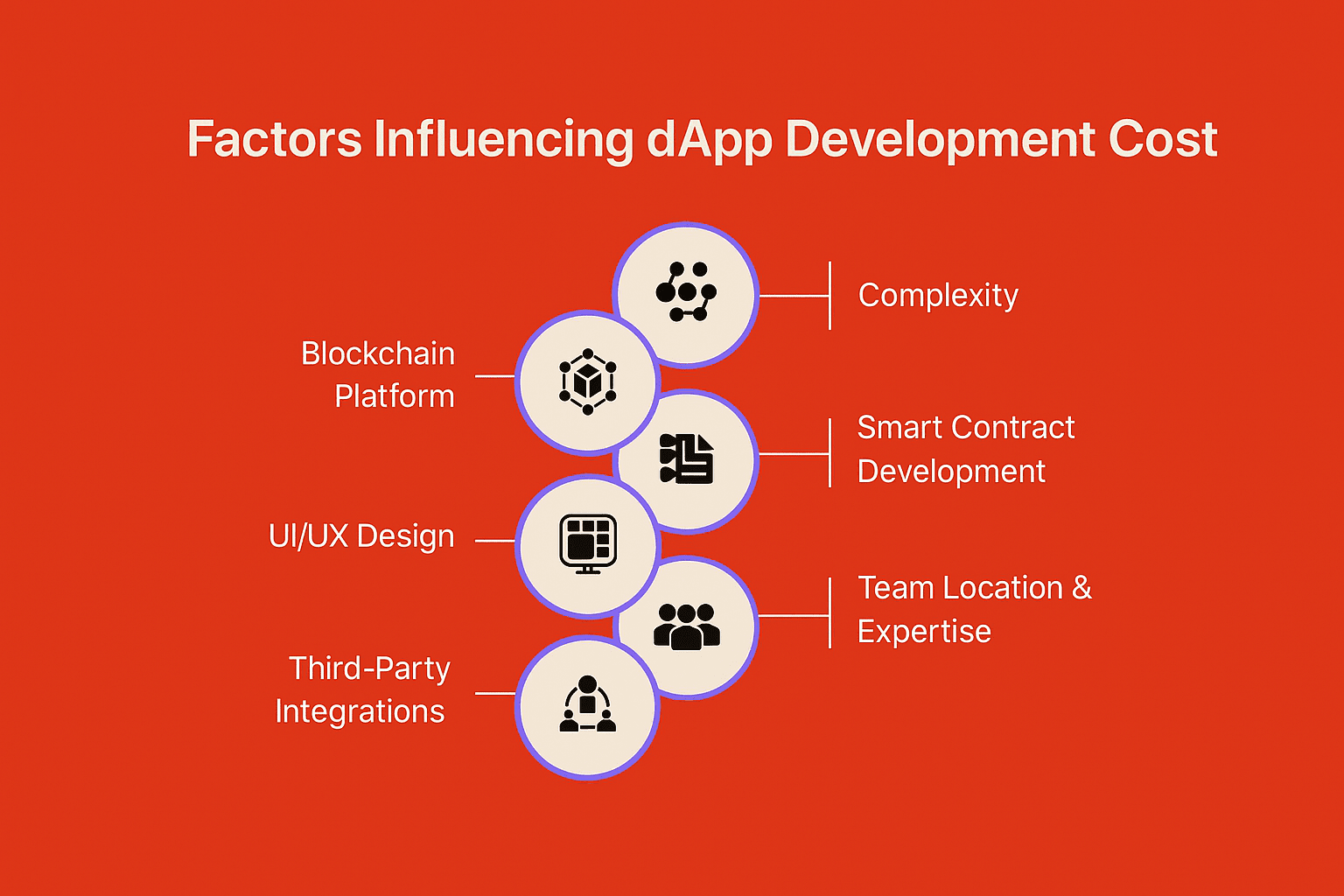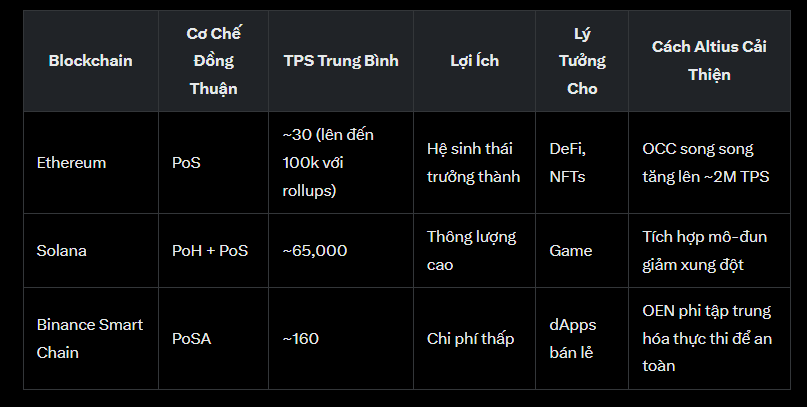By 2025, decentralized applications have cemented their status as the core foundation for a new era in software development. Not long ago, centralized financial applications were the standard – easy to build, easy to scale, and widely used.
But today, the world is undergoing a profound shift thanks to decentralization. At the center of this change? dApps, supported by blockchain technology, are redefining how we interact with digital systems.
According to recent market research, the global dApp development market was valued at $30 billion in 2024, and is expected to soar to $70.82 billion by 2030, with a compound annual growth rate (CAGR) of 18.74% from 2025 to 2030. This explosive growth is not just a trend; it represents a significant structural shift in how software is created and used. Over 70% of current blockchain activity comes from dApps, including decentralized finance (DeFi) such as Uniswap, gaming platforms like Axie Infinity, and NFT marketplaces like OpenSea.

These applications are rewriting the rules of digital interaction, expanding beyond cryptocurrency into industries like finance (borderless trading and smart contracts), gaming (true asset ownership and play-to-earn models), and supply chains (enhancing transparency and traceability).
However, despite this growth momentum, blockchain and dApp development still face persistent "pain points" in 2025: scaling congestion causing network bottlenecks, interoperability issues between chains leading to a fragmented ecosystem and bridge hacks, security vulnerabilities causing billions in losses, high energy consumption raising sustainability concerns, regulatory barriers, and user experience (UX) challenges hindering widespread adoption.
Introducing Altius Labs, a pioneering force in blockchain execution layer.
Through a modular architecture, parallel execution engine, and neutral VM framework, Altius is directly addressing these pain points, enabling developers to build dApps faster, more securely, and more interactively. This guide explores the journey of developing dApps while highlighting how Altius turns challenges into opportunities, positioning itself as a sustainable solution for Web3 builders.
Decentralized applications, or dApps, are software programs running on a blockchain network rather than centralized servers. Unlike traditional applications controlled by a single entity, dApps distribute logic and data across a peer-to-peer network, ensuring security, transparency, and censorship resistance.
In 2025, these characteristics are crucial amid increasing concerns about data privacy and centralization. However, pain points like slow transaction speeds (e.g., ~30 TPS of Ethereum during peak hours) and the interaction gap where chains like Solana and Ethereum struggle to communicate – have hindered widespread adoption.
Altius tackles this with Parallel Execution, achieving millions of TPS for non-conflicting transactions via OCC and ILP, reducing gas fees by 75% and allowing smooth scaling without sacrificing decentralization.
Benefits of dApps over traditional applications
dApps provide real benefits:
- Enhanced Security: Blockchain consensus mechanisms and encryption make data tampering nearly impossible.
- Greater Transparency: All changes can be verified on-chain, building trust.
- Empower Users: Users control their data and assets.
- Censorship Resistance: dApps continue to operate as long as the network is alive.
=> Altius amplifies these benefits through the Open Execution Network (OEN), where Executors stake tokens to take responsibility, penalize bad actors, and ensure safe operations consistent with incentives.
How are real dApps being built? How can Altius help?
There are many examples: Uniswap revolutionized DeFi with non-custodial swaps; Axie Infinity empowers gamers with earning NFTs; Decentraland builds a metaverse on digital land. In 2025, new cases like dApps abstracting chains for smooth multi-chain UX highlight potential – but also reveal pain points like bridge hacks, which complicate interoperability. Altius's neutral VM framework and modular stack enable true cross-chain interoperability, eliminating centralized bridges and reducing hack risks.
Let's explore the development process of dApp developers and see how Altius addresses key pain points at each step.

Step 1: Idea
Every successful dApp starts from a solid idea, focused on solving real problems that users face. However, in 2025, the ideation process is no longer simple. The explosion of blockchain technology forces developers to confront many pain points such as scalability limits – where networks are frequently congested, leading to high fees and slow transaction times – or a shortage of deep blockchain talent making recruitment harder and more expensive than ever.
According to recent reports, over 70% of blockchain activity comes from dApps. However, fragmentation between different chains has slowed down development, with issues such as interoperability and security still being major barriers.
This is where Altius Labs stands out as an advanced solution, helping developers overcome challenges by optimizing the execution layer, delivering high performance without sacrificing decentralization.
Identify the problem worth solving
First, ask yourself: What problem will my dApp solve? Focus on issues heavily affected by traditional centralization, such as lack of transparency in financial transactions, high costs due to intermediaries (banks, exchanges), or delays in data processing.
For instance: In DeFi, users often face network congestion on Ethereum, leading to skyrocketing gas fees and prolonged wait times. The average TPS on the mainnet is only about 16-30; even with Layer 2 it can reach up to 100k but still falls short of real demand.
Altius Labs directly addresses scalability issues through parallel execution technology on commodity hardware, reducing congestion like that on Ethereum, allowing dApps to run smoother without needing to invest in expensive infrastructure. In the context of 2025, as security threats such as 51% attacks or phishing attacks increase, Altius integrates staking and slashing mechanisms to ensure safety, making ideas viable and sustainable.
Pro tip: List specific issues such as “reducing transaction costs for freelancers in developing countries” or “increasing transparency in supply chains” and test for alignment with environmental sustainability trends – a major pain point as blockchain consumes massive energy.
Market research
After identifying the problem, do not rush into coding. Conduct market research to avoid reinventing the wheel. Use DAppRadar, Token Terminal, or GitHub to analyze existing dApps in your niche: What do they do well? What are they lacking?
For example: In DeFi, slow TPS is a significant gap. Reports indicate Ethereum only averages 47 TPS (combining L1 and L2) in 2025, leading to congestion and high fees during major events like flash loans or yield farming.
Altius Labs' benchmarks show GPS (Gas Per Second) rates over 1.8x higher than Reth/GetH – popular execution clients on Ethereum – making Altius the ideal choice for high-throughput dApps like gaming or NFT marketplaces.
Research should also track 2025 trends such as the rise of Real-World Assets (RWA) tokenization and AI integration, where interoperability between chains is a key factor. From there, you can uncover opportunities like building cross-chain dApps without easily hackable bridges – which caused losses of over $2.17 billion this year.
Define the unique value proposition (UVP)
Identify what makes the dApp stand out among thousands of competitors. The UVP (Unique Value Proposition) should answer: Who is the target audience? What do they need? Why choose you?
Formula: For [target audience], who are facing [problem], our dApp is a [type of product] that provides [key benefit].
For example: “For developers struggling with multi-chain fragmentation and low TPS in DeFi, Altius is a modular execution layer providing smooth interoperability and ~6635 TPS (25 times the Ethereum standard), outperforming competitors like Solana – although Solana achieves ~65,000 TPS, it has been criticized for low decentralization and centralization risks.”
This UVP attracts investors while guiding the entire project, ensuring that the dApp effectively addresses real pain points such as scalability limitations and smart contract vulnerabilities in DeFi.
Step 2: Planning
When the idea is formed, the planning step turns it into a specific strategy, including platform selection, technology, and team. By 2025, increasingly strict regulations (e.g., anti-money laundering laws for crypto) and technological complexities (like AI integration or preparing against quantum computers – quantum resistance) make this stage more important than ever.
Choose the right blockchain platform
When developers choose a blockchain, they need to carefully consider the needs of the dApp.
If building DeFi, Ethereum is often the top choice due to its large ecosystem with thousands of projects and a strong developer community. However, low TPS (~30 on mainnet, expected 400 TPS by the end of the year) makes Ethereum prone to congestion, leading to high fees and poor experiences.
In contrast, Solana stands out with TPS up to ~65,000, suitable for gaming or microtransactions, but criticized for low decentralization, centralization risks, and network reliability issues – as highlighted in the 2025 network health report.
Altius Labs' stack addresses this weakness by allowing flexible integration with any L1/L2, while providing a custom settlement and Data Availability layer like Celestia. This enables dApps to leverage the advantages of multiple chains without running into interoperability issues – a major pain point in DeFi in 2025.

Choose the right technology
Next, choose the tech stack:
Smart contracts: Solidity or Rust
Frontend: React or Next.js
Blockchain integration: Web3.js or equivalent libraries
In 2025, high scalability demands require additional optimization tools. Altius adds:
SSA (Static State Analysis) to track state dependencies, avoiding conflicts during parallel execution
SSMT (Sharded State Merkle Trie) for sharding storage, reducing I/O by up to 50% – especially useful for dApps handling large data like NFTs or supply chains
These optimizations reduce costs while addressing high gas fees on Ethereum – which is expected to remain a challenge even with the Pectra upgrade.
Build the ideal team
A strong team should include: blockchain developers, UX/UI designers, project managers, and QA engineers. However, talent shortages are a major pain point in 2025, especially for DeFi and Web3 experts.
Altius's Application Code Assessor encourages writing parallel execution-friendly code, reducing training time and bridging the talent gap through code optimization automation.
Step 3: Design
Design determines the success or failure of a dApp. Web3 users often struggle with complex UX like wallet interactions, gas fee confirmations, or navigating between chains – pain points that persist despite technological advancements.
Wireframe and prototype
Use Figma or Adobe XD to build user flows from onboarding to transaction. Altius ensures a smooth multi-chain UX through chain abstraction, allowing users not to switch wallets between Ethereum and Solana, reducing frustration and increasing adoption.
Best practices for UI/UX
Simplify transactions with tooltips, clear confirmations, and responsive design. Altius reduces gas fees by 75%, speeds up execution, and abstracts complex tasks like cross-chain swaps, making dApp more user-friendly – especially important as DeFi UX remains a major barrier in 2025.
Collect feedback
Conduct beta testing through Maze or Hotjar to gather feedback. Altius's modular architecture allows for rapid iteration and adjustments based on insights, ensuring the dApp aligns better with trends like mobile-first in gaming.
Step 4: Development
Development is the core stage, turning ideas into code. However, risks such as reentrancy attacks or routing attacks are still lurking, with over $2.17 billion in losses from hacks in 2025.
Develop smart contracts
When using Altius, developers optimize with ILP (Instruction-Level Parallelism), reducing gas by 75% and increasing TPS to ~2M for non-conflicting transactions – ideal for DeFi where scalability is a major issue.
Integrate frontend/backend
Connect using Web3.js or Ethers.js; Altius's OEN (Open Execution Network) securely handles off-chain logic, supporting indexing via The Graph, reducing latency.
Ensure security and scalability
Audit with CertiK or OpenZeppelin; Altius's stake/slashing mechanisms prevent exploitation, while SSMT extends state management, handling scalability for large dApps.
Step 5: Testing
Testing is mandatory, especially as network threats like phishing and endpoint vulnerabilities increase in 2025.
Unit and integration testing
Use Hardhat or Truffle; Altius simulates parallel execution to test conflicts, ensuring stable code.
Security audits
Combining manual and automated testing with MythX; Altius's OCC minimizes conflicts, enhancing attack resistance.
User acceptance testing
Gather feedback through surveys; Altius improves overall UX, making the dApp more easily accepted by the Web3 community.
Step 6: Deployment
Mainnet deployment
Smooth transition from testnet; Altius uses commodity hardware, making it easy to deploy for projects
Monitoring and analytics
Use Dune Analytics or The Graph; Altius's OEN provides real-time data on TPS and user engagement.
Post-launch support
Continuous maintenance with upgrades; Altius will continue to evolve through modular upgrades, supporting cross-chain and scalability, helping dApp adapt to changes like Ethereum's Pectra upgrade or Solana's 2025 roadmap.
Analyze investment costs for building dApps
Costs range from $20,000–$200,000+, affected by complexity and pain points like high gas fees.
Factors Affecting Costs
- Complexity: Advanced features increase costs.
- Platform: Ethereum is expensive; Altius reduces fees by 75%.
- Team: Lack of expertise increases costs; Altius optimizes development time.

Cost-saving strategies for devs
Here are some smart strategies to reduce costs while maximizing the features of Altius Labs to make the development process more efficient.
Instead of building the entire application from scratch, focus on core features to launch your product quickly and gather user feedback. This can reduce upfront costs by up to 40-50% and avoid wasting resources on unnecessary features. With Altius helping build faster, achieving high TPS without investing in expensive hardware, you can test and iterate on ideas cost-effectively.
Leverage available tools like OpenZeppelin for smart contracts or Truffle for testing, instead of developing from scratch. Altius Labs provides powerful open-source tools, such as SSA (Static State Analysis) and SSMT (Sharded State Merkle Trie), helping reduce I/O by up to 50% and optimize database performance – for instance, improving GPS by 1.8x compared to Reth/GetH. This not only saves programming time but also reduces long-term operational costs.
Work with blockchain expert teams in lower-cost regions, while still ensuring high quality. By integrating Altius, you can reduce the need for a large team because its modular architecture is easily customizable and integrates with any L1/L2, saving development time and reducing gas fees by up to 75%.
Use SDKs or white-label dApps for faster deployments, especially for DeFi or NFT platforms. Altius's Open Execution Network (OEN) allows cross-chain integration without centralized bridges, reducing hack risks and security costs – a significant pain point that has caused billions in losses this year.
By adopting these strategies, you not only save costs but also build sustainable dApps, ready for the growth of Web3. If you are a developer looking for optimal solutions, this is the time to try out Altius! Integrate Altius into your project today – visit the whitepaper at https://www.altiuslabs.xyz/blog/altius-whitepaper to get started, or join the community for free support.
Altius not only helps you save costs but also elevates your dApps to new heights with superior speed and security. Developers, don't miss out – build the blockchain future with Altius!
